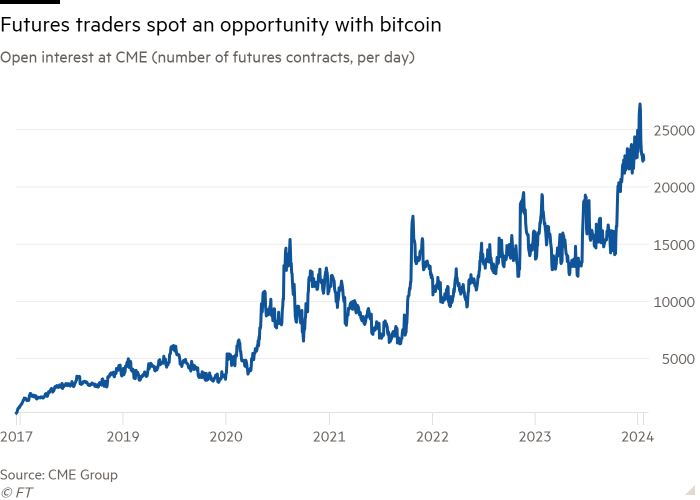Traders swoop on bitcoin ‘cash and carry’ trade after ETF launches

Roula Khalaf, Editor of the FT, selects her favourite stories in this weekly newsletter.
Futures traders have jumped on the arrival of the first US spot bitcoin exchange traded funds, ramping up a lucrative bet that capitalises on the volatile moves of crypto-related prices.
The number of bitcoin futures contracts open at Chicago’s CME Group has climbed to record levels in January as traders target a short-term return from the difference between those contracts and the spot price — aping a strategy that has long been popular in more established financial and commodity markets.
The open interest marker, a sign of the depth and liquidity of a futures market, has enabled CME to leapfrog Binance as the world’s largest exchange for trading derivatives of bitcoin. While Binance has thousands of retail customers, CME has traditionally catered to big asset managers, hedge funds and proprietary traders.
Average open interest at CME has hit 24,100 contracts this month, equivalent to about $4.6bn, up from 16,500 contracts for 2023. It climbed as high as 27,000 contracts, around $6bn, on January 12, the day US regulators approved the 10 new bitcoin ETFs.
An average of 66,000 bitcoin futures contracts at CME changed hands daily in January, representing a nearly 50 per cent jump month on month and surpassing their previous high in November 2022.
Traders say volumes have been boosted by applying a tried and tested strategy in other markets, known as a “cash and carry trade”, to bitcoin.
A trader can sell the future, which typically trades at a premium, and hedge it by buying the underlying asset. A spot bitcoin ETF also offers traders a cheaper and safer way to buy the cryptocurrency. The two prices typically converge as the futures contract nears expiry; traders say the trade generates up to a 15 per cent annualised return for little risk.
“It’s a simple carry trade and we know this stuff in Chicago,” said a longtime trader who declined to be identified. “Bitcoin presents a real opportunity for traders that understand forward curves to come in and provide liquidity and also take opportunistic positions.”
The much-hyped launch of these stock market funds that invest directly in bitcoin had been expected to attract a new class of institutional investors to the world’s most-traded cryptocurrency, further boosting its price. In fact, bitcoin has fallen sharply since the approval two weeks ago.
However, the surging futures interest indicates the participation of a class of traders who care less about the markets’ overall direction, and are instead focused on the arbitrage opportunities between bitcoin and its various derivatives.

“In essence, this surge in activity indicates a substantial demand for Bitcoin exposure among institutional investors, an unprecedented development in the market,” said Amberdata, a crypto derivatives trading research group, in a report last week.
Nikolaos Panigirtzoglou, an analyst at JPMorgan, said the arrival of spot bitcoin ETF was “likely to induce a significant change in the bitcoin market structure.”
He noted that onshore crypto exchanges and the CME have benefitted from US regulators’ crackdown on offshore exchanges like Binance. The shift “echoes the price discovery that is taking place in the traditional financial system, in particular in equities where ETFs are more prevalent,” he said.
Derivatives traders are also linking more of their strategies to the new bitcoin ETFs, particularly in the under-developed options markets, which allow wagers on swings in the price.
“The most exciting aspect of a spot Bitcoin ETF lies in its potential to significantly expand the nascent crypto volatility market,” Amberdata said.
Comments